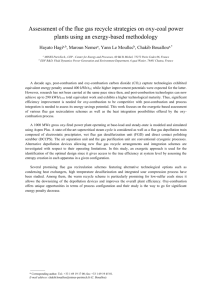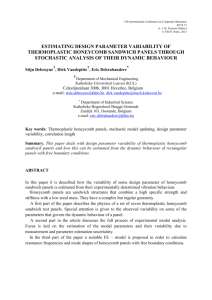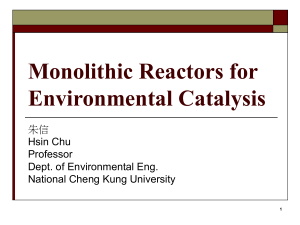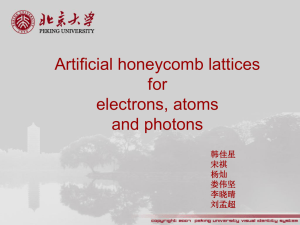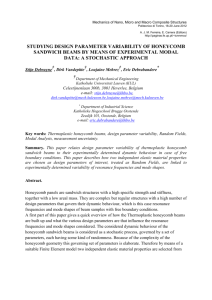Research Journal of Applied Sciences, Engineering and Technology 6(20): 3784-3797,... ISSN: 2040-7459; e-ISSN: 2040-7467
advertisement
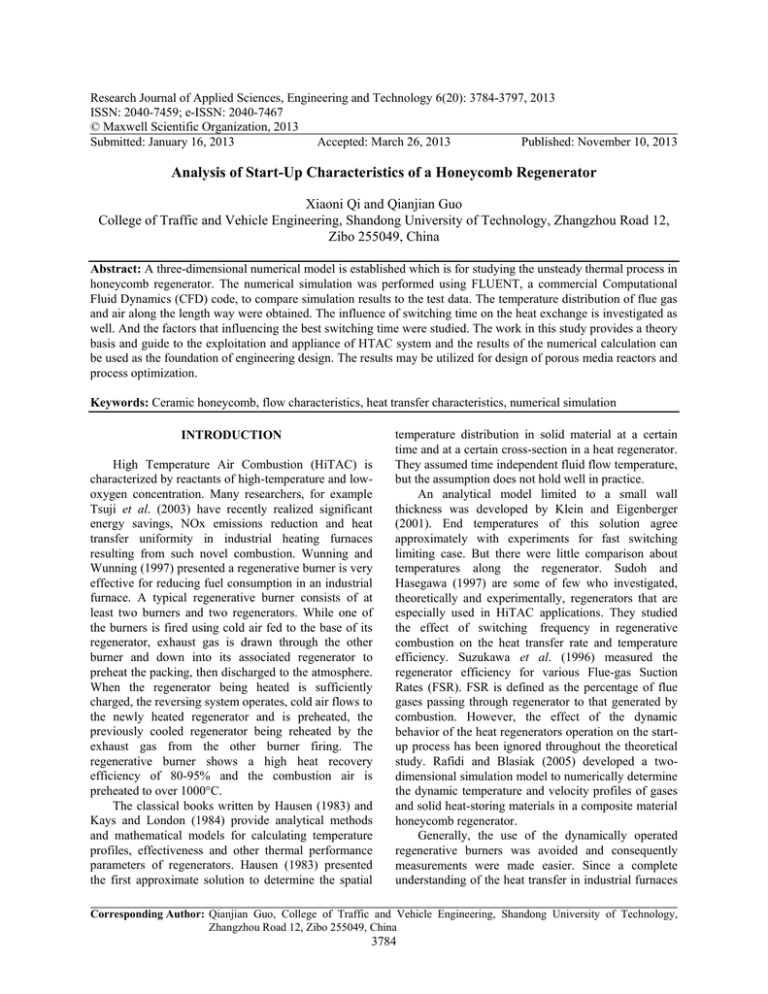
Research Journal of Applied Sciences, Engineering and Technology 6(20): 3784-3797, 2013 ISSN: 2040-7459; e-ISSN: 2040-7467 © Maxwell Scientific Organization, 2013 Submitted: January 16, 2013 Accepted: March 26, 2013 Published: November 10, 2013 Analysis of Start-Up Characteristics of a Honeycomb Regenerator Xiaoni Qi and Qianjian Guo College of Traffic and Vehicle Engineering, Shandong University of Technology, Zhangzhou Road 12, Zibo 255049, China Abstract: A three-dimensional numerical model is established which is for studying the unsteady thermal process in honeycomb regenerator. The numerical simulation was performed using FLUENT, a commercial Computational Fluid Dynamics (CFD) code, to compare simulation results to the test data. The temperature distribution of flue gas and air along the length way were obtained. The influence of switching time on the heat exchange is investigated as well. And the factors that influencing the best switching time were studied. The work in this study provides a theory basis and guide to the exploitation and appliance of HTAC system and the results of the numerical calculation can be used as the foundation of engineering design. The results may be utilized for design of porous media reactors and process optimization. Keywords: Ceramic honeycomb, flow characteristics, heat transfer characteristics, numerical simulation INTRODUCTION High Temperature Air Combustion (HiTAC) is characterized by reactants of high-temperature and lowoxygen concentration. Many researchers, for example Tsuji et al. (2003) have recently realized significant energy savings, NOx emissions reduction and heat transfer uniformity in industrial heating furnaces resulting from such novel combustion. Wunning and Wunning (1997) presented a regenerative burner is very effective for reducing fuel consumption in an industrial furnace. A typical regenerative burner consists of at least two burners and two regenerators. While one of the burners is fired using cold air fed to the base of its regenerator, exhaust gas is drawn through the other burner and down into its associated regenerator to preheat the packing, then discharged to the atmosphere. When the regenerator being heated is sufficiently charged, the reversing system operates, cold air flows to the newly heated regenerator and is preheated, the previously cooled regenerator being reheated by the exhaust gas from the other burner firing. The regenerative burner shows a high heat recovery efficiency of 80-95% and the combustion air is preheated to over 1000°C. The classical books written by Hausen (1983) and Kays and London (1984) provide analytical methods and mathematical models for calculating temperature profiles, effectiveness and other thermal performance parameters of regenerators. Hausen (1983) presented the first approximate solution to determine the spatial temperature distribution in solid material at a certain time and at a certain cross-section in a heat regenerator. They assumed time independent fluid flow temperature, but the assumption does not hold well in practice. An analytical model limited to a small wall thickness was developed by Klein and Eigenberger (2001). End temperatures of this solution agree approximately with experiments for fast switching limiting case. But there were little comparison about temperatures along the regenerator. Sudoh and Hasegawa (1997) are some of few who investigated, theoretically and experimentally, regenerators that are especially used in HiTAC applications. They studied the effect of switching frequency in regenerative combustion on the heat transfer rate and temperature efficiency. Suzukawa et al. (1996) measured the regenerator efficiency for various Flue-gas Suction Rates (FSR). FSR is defined as the percentage of flue gases passing through regenerator to that generated by combustion. However, the effect of the dynamic behavior of the heat regenerators operation on the startup process has been ignored throughout the theoretical study. Rafidi and Blasiak (2005) developed a twodimensional simulation model to numerically determine the dynamic temperature and velocity profiles of gases and solid heat-storing materials in a composite material honeycomb regenerator. Generally, the use of the dynamically operated regenerative burners was avoided and consequently measurements were made easier. Since a complete understanding of the heat transfer in industrial furnaces Corresponding Author: Qianjian Guo, College of Traffic and Vehicle Engineering, Shandong University of Technology, Zhangzhou Road 12, Zibo 255049, China 3784 Res. J. Appl. Sci. Eng. Technol., 6(20): 3784-3797, 2013 is always required in the design and optimization of dynamic heating processes. Our ambition in this study was to carry out studies on the start-up process in a furnace equipped with reverse regenerative burner systems. In this study a three-dimensional numerical simulation model for a ceramic honeycomb regenerator used for a HiTAC burner was developed. This kind of regenerator is either a fixed bed with randomly packed ceramic balls or having honeycomb structure with identical cells. In this study, it is based on finite volume methods and the commercial Computational Fluid Dynamics software-Fluent is used to simulate the dynamic process. Moreover, the model considers the temperature dependent thermal properties. By comparison, one-dimensional numerical simulation is not capable of considering all the above effects. The aim of the model is to obtain the temperature distribution of solid matrix and gases along the regenerator, the pressure difference across the regenerator at different operating conditions. It was verified with experiments that were performed on the same regenerator. SIMULATION MODEL Figure 1 shows the dimensions of one heat regenerator used in a HiTAC regenerative burner. regenerator dimension is 150W×150H×300L. All flue gases generated by combustion are sucked again by the burners and pass through the regenerators. The switching time can be set to a value between 15 and 60s. Geometry parameters of honeycomb cell: A threedimensional simulation model was developed to find out the temperature distribution of the solid storing material and flowing gases and other thermal and flow parameters for this regenerator and compare results with experiments. Because of geometric symmetry of the honeycomb structure, mathematical analysis was made on one honeycomb cell, or matrix, that formed a small part of the regenerator cross-section along the flow path (Fig. 1). In our test lab, there are 10 types of honeycomb cells, the side of which ranges from 2.1 to 5.0 mm. For such simple geometry with very small side, the flow is always laminar at nominal operating conditions and flue gases emissivity is low inside regenerator cells due to very short beam length, so the heat transfer by radiation is not taken into account in this study. Computational zone: Figure 2 shows the threedimensional zone in the simulation. It includes the solid material and flow path (the gas phase). The honeycomb cell is square-axisymmetric, the velocity, temperature and pressure distribution are all symmetric. So half the wall thickness, 1/4 flow path and the whole length of the cell is taken as the computational zone. Physical property parameters of gas and honeycomb: The flue-gas and the preheated air flow through the honeycomb alternately. As the difference of the physical properties between the gas and the air has small influences on the heat transfer performance of the honeycomb regenerator, the physical properties of the air is used instead of the gas in the numerical simulation for convenience. In fact the specific heat of flue gas is a little larger than that of the air, so the heat transfer between the flue gas and the honeycomb is a little more than the heat transfer between the honeycomb and the air if both of the switching times are the same. The temperatures of the air and the gas flowing through the honeycomb vary greatly, so their physical properties vary greatly correspondingly. The physical properties Fig. 1: Honeycomb regenerator and dimension of the ceramic material and flow path Table 1: Physical property parameters of air Temperature K 300 1500 Density kg/m3 1.1766 0.2350 Table 2: Physical property parameters of Mullite Temperature K Density kg/m3 300 2500 1500 2500 Isobaric specific heat J/(kg/K) 1005.7 1230.0 Thermal conductivity W/(m/K) 0.02624 0.09460 Thermal conductivity W/(m/K) 2.14 4.37 3785 Dynamic viscosity Pa/ S 18.46×10-6 54.00×10-6 Isobaric specific heat J/(kg/K) 800 800 Res. J. Appl. Sci. Eng. Technol., 6(20): 3784-3797, 2013 ∂ ( ρ w) ∂p + div( ρ wU )= div(η gradw) − ∂t ∂z (4) An energy balance was made in every domain in the channel, the flowing gases and solid domains. The problem is transient and the general energy balance equation is: ∂ ( ρT ) λ + div( ρUT = ) div( gradT ) + ST ∂t cp Fig. 2: Three-dimensional computation zone are assumed to vary linearly with the temperature. And the solid material is assumed to be Mullite, the thermal conductivity of which changes linearly with temperature. The physical property parameters of air and Mullite are listed in Table 1 and 2, respectively. Governing equations: In the honeycomb cell, gas attributes to the three-dimensional unsteady laminar flow. There are three different forms of heat transfer process, that is, the thermal conductivity of gas or air in itself; convection heat transfer between honeycomb and flue or air; thermal conductivity, thermal storage and thermal rejection internal honeycomb. In order to simplify the calculation, we made the following assumptions: The differences between the flue gas and air is ignored and the physical parameters of air is used instead of that of flue gas. radiation heat transfer in the channel is ignored Heat loss from the regenerator to the environment is ignored. The surface area and body mass distribution of the cell is uniform. The Cell surface is smooth: A typical set of equations for regenerative problem was used by Doermann and Sacadura (1996) and Hchert et al. (1999): equation of mass conservation, Navier-Stokes, thermal conductivity equation for gas, thermal conductivity equation for porous media and Ideal gas state equation. Mass conservation equation: ∂ρ ∂ ( ρ u ) ∂ ( ρ v) ∂ ( ρ w) + + + = 0 ∂t ∂x ∂y ∂z (1) Navier-Stokes equations: ∂( ρu) ∂p + div( ρ uU )= div(η gradu ) − ∂t ∂x (2) ∂ ( ρ v) ∂p + div( ρ vU )= div(η gradv) − ∂t ∂y (3) (5) where, S T , a sink or source heat, is zero in this case. The expression within brackets is the heat flux vector, which in this case includes the contributions from conduction and convection, respectively. The heat is transported by convection and conduction in the flow domain and only by conduction in solid domain. Therefore, the energy equation of the solid material domain is: ∂ ( ρTs ) λ = div( gradTs ) ∂t cp And the energy equation of the flowing gases domain is: ∂ ( ρTg ) ∂t λ + div( ρUTg ) = div( gradTg ) cp Energy conservation Equation: ∂ ( ρT ) λ + div( ρUT ) = div( gradT ) ∂t cp (6) Ideal gas state equation: p = ρ Rg T (7) Boundary conditions: Since the symmetry of the flow and heat transfer in the three-dimensional flow zone of the honeycomb, the four exterior sides along the direction of the gas flow is defined as symmetric boundary as shown in Fig. 2. The solid surface of the both ends of honeycomb is defined as adiabatic boundaryconditions. Coupling boundary conditions are used on the two interior surfaces where the honeycomb is in contact with the flowing gas. Because the heat transfer between the honeycomb and the gas is continuous and the temperature and the heat flux are both affected by the interaction with the wall, no matter the temperature or the heat flux on the interface are parts of the results. 3786 Res. J. Appl. Sci. Eng. Technol., 6(20): 3784-3797, 2013 Obviously the two contact surfaces can not be used as the first, second or third type of pre-specified boundary conditions. Boundary conditions such as these dynamically determined by the thermal transformation process, which can not be predetermined, is known as conjugate heat transfer. The coupled boundary conditions at the intersection of the two-phase interface can be listed by the following expressions: Tw honeycomb = Tw gas qw honeycomb = qw gas (Continuous Temperature) (Continuous heat flux) where, the subscript-honeycomb and gas mean the simulation regions respectively, w means the interface between the two regions. The gas mass flow rates of the two heat-exchange stages in one working cycle should be the same. However, the inlet temperature of flue gas is 1500 K and that of air is 300 K. The density of cold air is about four times larger than that of flue gas. So the inlet velocities of the two flows differ widely because of the differences of the temperatures of flue gas and cold air. During the heating period, the inlet end of hot flue gas is defines as the inlet boundary condition, where the speed and the pressure are set to a specific value and 0Pa, respectively. While the other end of the cold-side is set to pressure outlet. During the cooling period, the inlet end of cold air is defined as velocity inlet and the pressure is 0Pa, the other end is set to pressure outlet. As the honeycomb hole is 5 mm, the gas inlet velocity is 10 m/s, the dynamic viscosity is 18.46×106Pa • s and the density is 0.235 kg/m3, the Reynolds number is the largest: 𝑅𝑅𝑅𝑅𝑚𝑚𝑚𝑚𝑚𝑚 = 𝜌𝜌𝜌𝜌𝜌𝜌 𝜇𝜇 = 0.235×10×5×10 −3 18.46×10 −6 ≈ 636.5 For such simple geometry with very small diameter, the flow is always laminar since local Re ranges between 90 and 1000 at nominal operating conditions and therefore, the velocity profile and pressure drop across the regenerator can be determined from the solution of Navier-Stokes equation. Since the local Remax is much smaller than 2000 (the critical Renolds in a smooth tube), the flow can be considered as laminar. In practice, the actual critical Reynolds number may be reduced because of the wall roughness and the flow near the wall region tends to be turbulent, which may strengthen the local heat transfer. However, this effect can be corrected by means of experiments, or suitable correction factor is used in the numerical heat transfer according to Jia (2003). The local heat transfer caused by the roughness is ignored and the surface of the cellular surface is assumed to be smooth. Switching condition: Heating or cooling period is half of one cycle time. The ending of heating period is the starting time of cooling period. Similarly, the ending of cooling period is the starting time of heating period. The switching operation is instantaneous and it did not take time. The physical properties and the temperature of honeycomb, the temperature, physical properties and flowing condition of gas do not change. Before and after the moment. When the heating period is finished, the cooling end that is pressure outlet before the switching time changes to velocity inlet and the heating end that is velocity inlet before the switching time changes to pressure outlet. Correspondingly, when the cooling period is finished, the heating end that is pressure outlet before the switching time changes to velocity inlet and the cooling end that is velocity inlet before the switching time changes to pressure outlet. A commutation cycle consists of a heating period and a cooling period. The calculation repeats the cycle until the process becomes a stable state. Initial conditions: When the furnace starts working, the temperature of regenerator increases slowly from the ambient temperature, so the initial temperature values of honeycomb and air are set to ambient temperature, T0 = 300 K; the initial velocity of gas is set to 0, u = v = w = 0m / s; the initial pressure is 0, P0 = 0Pa. The initial temperature of the cellular ceramic body is set to 300 K when the detailed starting characteristics are investigated. In other cases the initial value of the temperatures are set to 900 K, which is the mean value of the inlet temperature of flue gas-1500 K and the inlet temperature of air. So that the time that the honeycomb regenerator takes to reach to the stable working conditions greatly reduces. And it saves the computing time. Computation ending condition: When the difference of the exit temperature of air and flue gas at the end of one cycle between those at the end of the previous cycle Fig. 3: Meshing of the computational zone 3787 Res. J. Appl. Sci. Eng. Technol., 6(20): 3784-3797, 2013 is less than 0.2°C, then we consider that the honeycomb regenerator has reached to stable working condition and the calculation process is completed. Computational process: The computations are initiated using cold start initial conditions and executed for one complete cycle of operation, i.e., the duration for both the regeneration and the combustion periods. The results are then saved in the computer and the final temperatures are set to be the initial conditions of the next run. The computations were executed repeatedly until the temperature profiles just before the change over are the same as the previous data, periodic steady state. The meshing of the computational zone is shown in Fig. 3. The governing integral equations for the conservation of mass and momentum and for energy and other scalars such as turbulence and chemical species were solved through control-volume-based technique. Pressure and velocity field are computed by Semi-Implicit Method for Pressure-Linked Equations (SIMPLE) algorithms. The convergence criterion for energy equation was that the residual error was less than 10-6, whereas for other governing equations it was 10-3. In this study, all residual errors of the degree of freedom were set by 10-3, which is satisfactory for simulation analysis. EXPERIMENTAL INVESTIGATION Experiments were carried out on honeycomb regenerators that are contained in a methane oxidation reactor. For completeness, a simple description of the reactor is given here. Tests of temperatures were carried out in a reverse flow reactor. The reactor is 600 mm wide, 600 mm high and 300 mm long. The entire configuration of the test apparatus is shown in Fig. 4. In a reverse flow reactor the feed is periodically switched between the two reactor ends using switching valves. When switching valves 1 and 4 are open, the feed flows to the reactor from left to right (forward flow), indicated by the solid arrows. When switching valves 2 and 3 are open, the feed flows to the reactor from right to left (reverse flow), indicated by the dotted arrows. The total cycle consists of these two operations and the term switch time denotes the time at which the flow is changed from forward to reverse flow or from reverse to forward flow. The sum of the times for forward and reverse flow is the cycle time. In this experiment the flue gas is substituted by hot air. Thermal energy carried by hot air can be captured by the solid heat storage medium. Then, with switching the flow direction, the captured thermal energy within the heat storage medium can be used to preheat the air. In the experiments, the ceramic honeycomb monoliths were used as heat storage medium. The monoliths consist of a structure of parallel channels with porous walls. The monolith properties are as same as that used in the model. To prevent heat losing from the reactor to the surroundings, the reactor was surrounding with a layer of insulation ceramic fiber blanket 350 mm thick. Thermal conductivity of the ceramic fiber blanket is 0.144 W/(m·K). Air and the hot air were supplied to the reactor using an air compressor. The flow rate of inlet was measured using a flow rate meter. Thermal profiles from the reactor were obtained using twelve thermocouples (denoted from 1 to 12 in Fig. 1). All thermocouples were placed along the centerline of the reactors. The data acquisition system recorded all sensor values. Data were saved as data files for analysis. Fig. 4: Configuration of the test apparatus 3788 Res. J. Appl. Sci. Eng. Technol., 6(20): 3784-3797, 2013 Fig. 5: Experimental and mathematical temperature of flue gas inlet The calculated temperatures of flue gas inlet were compared with the ones measured as shown in Fig. 5. The temperature of those 12 points was measured by 12 thermocouples. During the measurements there should be no flame in the combustion space. Therefore, the measurements were performed in the 2 sec gap between the intervals. It is shown in Fig. 5 that the measured temperatures of inlet flue gas are generally less than the simulated values. The reason may be the radiation of the hot air is ignored in the model. However, the tendency of the temperature is the same as the experiment. RESULTS For a 3-D numerical simulation model, the structure and meshes were constructed by GAMBIT and then numerical solution was obtained from the commercially available CFD code FLUENT to investigate the thermal dynamic behavior of the honeycomb regenerator starting-up process. The thermal behavior of the starting-up system has been simulated numerically for some cases. In case 1, side length of the cellular pore is 2.1 mm, the thickness 0.4 mm, the length is 300 mm, inlet gas flow rate is 7 m/s, air inlet velocity is 1.4 m/s and the switching time is 30 sec. Start-up analysis: There are generally two phasesstartup and steady-state operation after the honeycomb regenerator begins to study from the room temperature. This study simulated the startup process of the honeycomb regenerator in HiTA system of which the initial temperature is 300 K. When the system starts working, high temperature flue gas of 1500 K enters the cell body from one end. After one switching period (half of one complete cycle of operation), the flue gas is stopped sucking from the furnace. After one switching period the air is stopped entering the cell and the flue gas is blown again into the honeycomb cell from the other end, the cycle was executed repeatedly until the temperature are the same as the previous data, the cycle becomes steady state. The transient temperatures of the flue and the air under the above condition are shown in Fig. 6. Figure 7 shows the average outlet temperature of the air increases sharply in the first few cycles and then the increasing speed gradually slows down, finally tends to level. This is because in each regenerative period (heating period) the absorbing heat of honeycomb from the flue gas is greater than the heat carrying by the air in the endothermic period (cooling period). So at the each end of the cycle there is some excess heat remaining in the honeycomb body which leads to the temperature rising of the cellular body and the air outlet temperature also rises after preheating. Figure 7 shows the exit temperature of flue gas rises with the switching time gradually increasing and tends to level until stable. This is due to accumulation of heat in the cellular body and the rising of temperature, which 3789 Res. J. Appl. Sci. Eng. Technol., 6(20): 3784-3797, 2013 Fig. 6: Transient temperature of flue gas inlet during start-up period Fig. 7: Transient temperature of flue gas outlet during start-up period makes the temperature difference between the flue gas less and the endothermic heat is getting more and more, and the honeycomb decrease and the heat transfer until the two tends to the balance and the steady state. weaken. Thus in the regenerative stage the heat that can The reason is that in the starting-up stage, the be absorbed by the air and the heat that the flue gas temperature of the cellular body is very low (300 K), gives off decrease and the outlet temperature of the flue which has a large temperature difference with the gas gradually increases. high temperature flue gas, thus generating a strong In the dynamic starting-up process of the convective heat transfer in the regenerative stage. In the honeycomb from the beginning to the stable condition, exothermic stage, the temperature of the cellular body the regenerative heat of each cycle is getting less and is still low, which has a small temperature difference 3790 Res. J. Appl. Sci. Eng. Technol., 6(20): 3784-3797, 2013 Fig. 8: Air velocity distribution along the length Fig. 9: Cross-sectional velocity distribution of gas between the cold air, so the heat transferring to the cold air is small. With the increasing of the switching times, the temperature of the honeycomb becomes higher and higher, which makes the heat transfer of the honeycomb with the flue gas gradually weakened but the heat transfer with cold air gradually enhanced. The exothermic heat being greater than the endothermic heat is the basic characteristics of the starting-up process. When the exothermic heat is equal to the endothermic heat, honeycomb regenerator attains to the steady state and the starting-up process is over. It was shown in Fig. 6 and 7 that no matter for the air and the flue gas, the transient temperature between the end of the ninth and the eighth cycle is slight. It can 3791 Res. J. Appl. Sci. Eng. Technol., 6(20): 3784-3797, 2013 be concluded that the starting-up period is complete and the heat transfer enters into stable stage. In this simulation, the switching time is 30s, namely, one cycle time is 60s. So the entire heating period takes 9 cycles, about 540s. After the starting-up period, the outlet temperature of the air reaches up to 850 K, which shows that the heat transfer results have been very obvious. The air velocity distribution: Figure 8 shows the twodimensional velocity distribution of the air along the central axis at the end of the heating time. From the figure we can obtain the flue gas velocity distribution along the length of the cell. The flue gas is sucked uniformly into the channel at 7 m/s speed. But the size of the channel is too small and the gas becomes laminar distribution gradually. The gas near the wall at the Fig. 10: Gas velocity distribution at the end of heating period Fig. 11: Temperature distribution of gas along the length 3792 Res. J. Appl. Sci. Eng. Technol., 6(20): 3784-3797, 2013 entrance region flows significantly more slowly than 7 m/s, but the maximum speed of the center line is more than 14 m/s. As the flue gas flows into the channel, the velocity gradually decreases, the temperature decreases and the density increases, but the mass flow rate remains the same. Figure 9 is the two-dimensional cross-sectional velocity distribution of gas at the end of heating period. The velocity distribution in the middle section along the honeycomb height is the typical distribution curve. Figure 10 shows the one-dimensional velocity distribution on the symmetric boundary. We can see that the left points are in the honeycomb region, the speed is zero because the honeycomb does not move. The right side indicates the channel in which the velocity distribution of gas appears a parabolic distribution. The gas velocity is positive, indicating the upward flow of gas. The speed curve is as same as the typical laminar flow velocity distribution, which verifies the correctness of the previous theory-the gas flow in the channel is the laminar flow. But it is worth noting that the smaller channel size will make the influence of the wall roughness on the flow and heat transfer becomes relatively larger, namely, the local turbulence appears near wall, which strengthens the heat transfer between the wall and fluid. However the simulation did not consider this factor, there might be somewhat error between the actual value and the calculated value of the honeycomb wall temperature. Temperature distribution of honeycomb and gas: Figure 11 is the two-dimensional temperature distribution along the center line profile at the end of the heating period. In Fig. 11, 1500 K high-temperature flue gas entering from the left has reached saturated condition after one switching time. Now there is almost no temperature difference between the honeycomb and flue gas, which means there is no heat storage capacity in the honeycomb. With the flue gas flows to the left, the flue gas temperature decreases gradually until it reaches about 600 K when flowing out of the right exit. Figure 12 shows the one-dimensional temperature distribution on the symmetric boundary of which profile is at the flue entrance of the honeycomb. The figure is the temperature of the gas in the channel. It can be seen that the flue gas temperature distribution appears a parabolic distribution. The temperature gradient near the wall is larger and that near the center line is smaller, which indicates that the closer the wall, the greater the intensity of convective heat transfers. Although the channel size is small, the difference between the maximum temperature on the center line and the wall temperature amount to dozens of centigrade, which means that the heat transfer between the flue gas and the honeycomb wall is very strong. Figure 13 shows the temperature of gas and honeycomb along the length center axis of the cell at Fig. 12: Cross-sectional temperature distribution of gas 3793 Res. J. Appl. Sci. Eng. Technol., 6(20): 3784-3797, 2013 Fig. 13: Temperature distribution of wall and gas Fig. 14: Pressure distribution of gas along the length the end of heating period. 0 mm and 300 mm on the abscissa of this curve mean the gas inlet and outlet respectively. We can see from the figure that the temperatures decrease with the length increasing. The two curves are both “S "-shaped curves, but the shape is irregular. At the inlet and exit, the temperature difference between the cellular body and flue gas is less, but with the length increasing, the temperature difference between the two increases gradually. At the inlet of flue gas is very close to the honeycomb body of the furnace, of which the temperature range is between 1500 K~1300 K. In the practical application the honeycomb of here is very easy to be damaged. Thus the material utilized should be resistant high temperature of 1500 K, good quality and thick wall. Honeycomb thickness, wall damage due to the impact of honeycomb produced. That is, near the entrance to the cold air side of the honeycomb body temperature between the 300 K~900 K, we can choose refractoriness low, low prices and thin wall honeycomb. Of course, the central regenerator can also select the appropriate honeycomb. This can optimize the configuration of different materials and different parameters of the honeycomb structure, with the formation of high and low, reduce investment and maintenance costs. Pressure distribution of gas: A honeycomb with excellent performance, not only have a good effect of heat transfer, flow should also avoid large pressure loss, which is composed of local resistance of inlet and outlet and friction loss and the latter amounts to the most. Figure 14 shows the two-dimensional pressure distribution along the length of honeycomb at the end of the heating period. The left end is hot-flue gas inlet and the right end is cold-flue gas outlet. Assuming that the flue outlet pressure is 0 Pa, the flue inlet is 688 Pa and the total pressure loss is 688 Pa. Because the gas in the cellular body is the laminar flow, the pressure loss along the flow should be proportional to the average velocity, namely proportional to the Reynolds number, but has nothing to 3794 Res. J. Appl. Sci. Eng. Technol., 6(20): 3784-3797, 2013 Moreover, we found a 0~2s fluctuation in Fig. 3 to 9, the reason is the gas has its velocity before switching and it can not change the direction immediately after switching, now the reverse gas flows into the cell, both of the forward contacts and collides, which results in confusion, so there is a little fluctuations in the gas outlet temperature over a short time, but gradually returns to normal. Switching time: • Fig. 15: Transient temperature distribution of gas outlet do with the roughness of the pipe inner wall. However, the Reynolds number of the air in the channel changes with time and space in the channel that is; it has the relationship with the gas velocity, temperature and density. The gas pressure at the same height does not change, but the pressure loss along the length dramatically changes, because the gas velocity along the height direction dramatically changes. The closer the gas is to the hot end of the honeycomb, the greater the speed is, the greater the pressure loss of unit height is; The closer the gas is to the cold end of the honeycomb, the smaller the speed is, the smaller the pressure loss of unit height is. From Fig. 14, we can also find that the pressure gradient is smaller and smaller from left to right, which means that the smaller the speed, the smaller the pressure loss. So why the pressure loss in the heating period is much larger than that in the cooling-off period? Why is this? This is because that the average velocity of the hot gas is greater than that of the cooling air. And because of the temperature, the gas viscosity in heating period is greater than that in cooling period. So the pressure loss in the heating period is larger than that in the coolingoff period, which agrees with the pressure loss principle of laminar flow. Influence of switching time: Switching time is the most important operating parameter in the HiTAC system. It directly affects air outlet temperature, flue gas outlet temperature and the temperature efficiency and the heat recovery efficiency of the honeycomb. If the honeycomb structure parameters and other operating parameters are determined, the longer the switching time, the lower the air outlet average temperature, the higher the average temperature of flue gas outlet and the lower the heat recovery efficiency. On the contrary, the shorter the switching time, the higher the air outlet average temperature, the lower the average temperature of flue gas outlet and the higher the heat recovery efficiency. If the switching time is increased, then in the heating period (half cycle), the heat carrying into the cell from the flue increases, heat storage and the average temperature of the honeycomb increases, the temperature difference and the heat exchange per unit time between the flue and the cell decreases, so the average temperature of flue gas outlet increases and the heat recovery efficiency decreases; in the cooling period (half cycle), the average temperature of the honeycomb decreases, the temperature difference and the heat exchange per unit time between the flue and the cell decreases, so the average temperature of flue gas outlet increases and the heat recovery efficiency decreases. If the switching time is too long, too much heat energy in the flue gas can not be absorbed by the honeycomb, then the air can not absorb enough heat from the honeycomb, the heat storage capacity of honeycomb appears inadequate, so the heat recovery efficiency will be dramatically reduced. Transient temperature distribution of gas outlet: Figure 15 shows the transient temperature curves of flue outlet and air inlet under the above working condition. In the heating period, high temperature flue gas releases heat to the honeycomb. With heating time prolonging, the temperature of honeycomb gradually • increases and the flue gas temperature decreases and the temperature differences between the cell and the flue decreases, the heat storage capacity decreases, so the air temperature gradually rises and rise more and more. In Fig. 3 to 9 the air exit temperature curve almost linearly rise, but the rising speed is not very significant. Similarly, with time prolonging in the cooling-off • period, the temperature and the heat capacity gradually decreases, so the air outlet temperature decreases gradually and the decreasing speed is high, which is more obvious than that in the heating period. 3795 Determination of the best switching time: As stated above, the switching time is the most important operating parameter in the HiTAC system, it has influences not only on the honeycomb regenerator thermal efficiency, but also on the system security. So how to determine the best switching time? The switching time should not be too long. The HiTAC system must ensure that the average temperature of preheated air outlet is as high as the spontaneous ignition temperature under the local oxygen concentration. (about 1000°C, a little Res. J. Appl. Sci. Eng. Technol., 6(20): 3784-3797, 2013 • different with different fuel types and different oxygen concentration), which makes the fuel spontaneous ignite in the furnace. Moreover, in order to avoid damage to the induced draft fan and the valve, the system must ensure that the maximum outlet temperature of flue gas does not exceed the working temperature of the device. (about 200°C) Switching time can not be too short, which must ensure that the preheated air enters the furnace from the switching valve and combustion is safe The best switching time should include the following characters: the best economy, i.e., heat recovery efficiency of honeycomb regenerator is high and fuel costs is saved; the life of the equipment should be as long as possible and the equipment loss is saved; The gas pressure loss is small and power consumption is saved; the volume of the regenerator is not too large in order to save investment and maintenance costs. If the honeycomb structure of regenerator parameters and other parameters has been determined, then how is the switching time determined? The theoretical heat recovery efficiency curves and the theoretical temperature efficiency curves should be plotted out according to the equipment structure parameters and other parameters. Then the equipment loss and the power loss because of the pressure loss should be calculated. Thus the best switching time can be determined. We will further precede the study. When the honeycomb regenerator parameters and other operating parameters of the structure has two or more from time to time, must be determined in addition to the time but for the other parameters. For example, flue gas containing dust and more need to choose the larger size of the honeycomb holes to avoid channel blockage and then select the appropriate length of regenerator (i.e., height) and the regenerator crosssectional area, then the above methods can be used to determine the most Good for the time. CONCLUSION Honeycomb regenerator is an important part of high temperature air combustion system. This study focuses on the flow and heat transfer of the flue gas and preheated air. In addition, the heat transfer of honeycomb is considered as well. In this study, numerical simulation method is used to study the factors that influence the heat transfer characteristics of the gas and the honeycomb in the start-up period. Moreover, the model was validated with the experimental data. The following conclusions were obtained: • • • • • • • The flue gas and air inlet temperature curves change with the cycle and the changing discipline of the gas inlet temperatures were obtained. And then the heat transfer between the gas and the honeycomb was analyzed. According to the analysis, the duration time of start-up period can be roughly calculated, which provides reference for further study. The velocity distributions on the cross-section or the section along the length were obtained, which verified the laminar flow of the channel. This conclusion provides reference to optimizing the flow. The gas and honeycomb distribution temperature distributions on the cross-section or the section along the length at the end of the heating period were obtained. The characteristics and the reason of the temperature distribution were analyzed, which provides a reference for further research. The pressure distribution along the honeycomb were obtained, the reasons for the loss of production and the method to reduce the pressure loss were analyzed. The transient temperatures curve of flue gas inlet and air inlet were obtained and the temperature fluctuations by the intersection of cold and hot airstream forward were analyzed. The influences of switching time on the heat transfer efficiency and temperature efficiency was analyzed. And the principle of best switching time was presented, which can be used as the foundation of engineering design. Nomenclature: Cp P ST T T U x, y, z : : : : : : : Heat capacity (kJ/kg.K) Pressure (Pa) Physical enthalpy (kJ/cycle) Temperature (K) Time (s) Velocity (m/s) Cartesian coordinate Greek symbols: μ : Viscosity ρ : Density s : Time constant (s) Subscripts and superscripts g : Gases s : Solid ACKNOWLEDGMENT This study was financially supported by Key Program of National High Technology Research and Numerical model of honeycomb regenerator was Development Program of China (No.2009AA063202) presented and the whole start-up process was and Project of Shandong Province Higher Educational simulated by means of CFD commercial softwareScience and Technology Program (J11LD22). Fluent. 3796 Res. J. Appl. Sci. Eng. Technol., 6(20): 3784-3797, 2013 REFERENCES Doermann, D. and J.F. Sacadura, 1996. Heat transfer in open cell foam insulation. J. Heat Transf., 118: 88-93. Hausen, H., 1983. Heat Transfer in Counter Flow, Parallel Flow and Cross Flow. McGraw-Hill, New York. Hchert, C.L., V.J. Lellze and O.A. Ezekove, 1999. Combustion and heat transfer in two dimensional porous media. Combust. Flame, 116: 177-191. Jia, L.D., 2003. Application of honeycomb regenerative burner on reheating furnace for rolling. Ind. Furnace, 55: 23-25. Kays, W.M. and A.L. London, 1984. Compact Heat Exchanger. McGraw-Hill, New York. Klein, H. and G. Eigenberger, 2001. Approximate solution for metallic regenerative heat exchangers. Int. J. Heat Mass Tran., 44: 3553-3563. Rafidi, N. and W. Blasiak, 2005. Thermal performance analysis on a two composite material honeycomb heat regenerators used for HiTAC burners. Appl. Therm. Eng., 25: 2966-2982. Sudoh, J. and T. Hasegawa, 1997. Development of an advanced industrial burner for high temperature air combustion. Proceeding of the Japanese Flame Days 97, JFRC 20"' Anniversary, Osaka, Japan. Suzukawa, Y., S. Sugiyama and I. Mori, 1996. Heat transfer improvement and NOx reduction in an industrial furnace by regenerative combustion system. Proceedings of the 31st Intersociety on Energy Conversion Engineering Conference (IECEC 96), Washington, DC, 2: 804-809. Tsuji, H., A. Gupta and T. Hasegawa, 2003. High Temperature Air Combustion from Energy Conservation to Pollution Reduction. CRC Press LLC, New York. Wunning, J.A. and J.G. Wunning, 1997. Flameless oxidation to reduce thermal NO-formation. Prog. Energ. Combust. Sci., 23: 81-94. 3797
